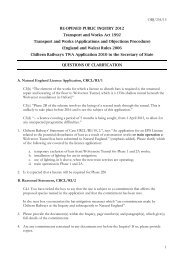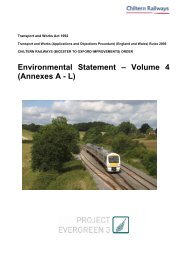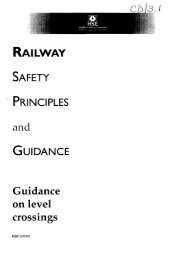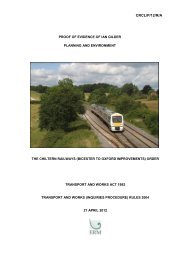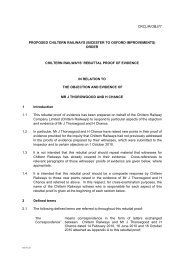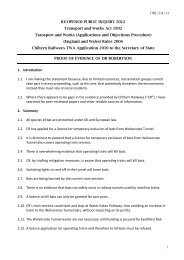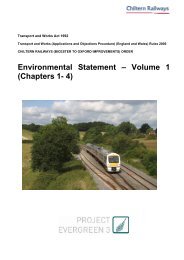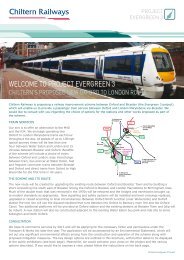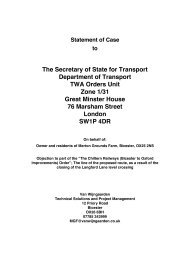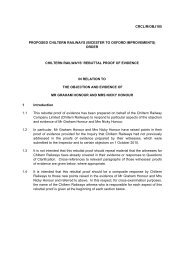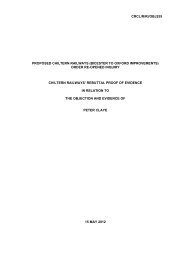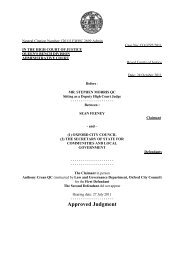Public Rights of Way Report - Chiltern Evergreen3
Public Rights of Way Report - Chiltern Evergreen3
Public Rights of Way Report - Chiltern Evergreen3
You also want an ePaper? Increase the reach of your titles
YUMPU automatically turns print PDFs into web optimized ePapers that Google loves.
4.10 Crossing users particularly at risk include the young, the elderly and infirm,dog walkers and migrant workers who don’t understand the signs (1) . Mostlevel crossing fatalities occur on ‘passive’ crossings, where the responsibilityfor ensuring it is safe to cross lies mainly with the user (2) . This is despite thefact that these crossings are mostly in remote locations and carry by far thelowest volume <strong>of</strong> vehicles and pedestrian traffic. Table 4.2 shows the accidentrates for these crossings.Table 4.2:Accident Rates at Passive Crossings [% <strong>of</strong> total collisions and pedestrianfatalities at all crossings]Type <strong>of</strong> CrossingNumber and % <strong>of</strong>Level CrossingsNationally2008Number and % <strong>of</strong>Collisions withRoad Vehicles1999-2008Number and % <strong>of</strong>Pedestrian Fatalities1999-2008All Level Crossings 6,542 169 63Passive Crossing withminiature warninglights eg Islip LevelCrossingOther PassiveCrossings (includingfootpath crossings)105 11 41.6% 6.5% 6.4%5,035 50 2077.0% 29.6% 31.8%Source: Rail Safety & Standards Board Annual Safety Performance <strong>Report</strong> 2008.4.11 Over 90% <strong>of</strong> level crossing risk in the past decade has resulted from eithererror or misuse. Typical examples include incorrect knowledge <strong>of</strong> operation,misjudging the time if takes for a train to reach the crossing, people drivingaround barriers, people crossing when the lights are red and people leavingmanually-worked gates open after use (3) .National Policy on Rail Safety4.12 National policy is to reduce the risk from level crossings wherever possible,preferably by closure and/or replacement. This is reflected in the policies <strong>of</strong>the three relevant safety bodies: the Office <strong>of</strong> Rail Regulation, the RailStandards & Safety Board and Network Rail.4.13 The Office <strong>of</strong> Rail Regulation is responsible for overall railway safety policyand guidance, and for the inspection and certification <strong>of</strong> new facilities. Itstates that rail companies should take all reasonable opportunities to removeor replace existing level crossings (4) .(1) Paper to RSSB Board 13th December 2007 “Road-Rail Interface”.(2) Rail Safety & Standards Board Annual Safety Performance <strong>Report</strong> 2008.(3) Network Rail “Our Approach to Managing Level Crossing Safety”.(4) Office <strong>of</strong> Rail Regulation “Policy on Level Crossings”, February 2007.ENVIRONMENTAL RESOURCES MANAGEMENT13CHILTERN RAILWAYS



